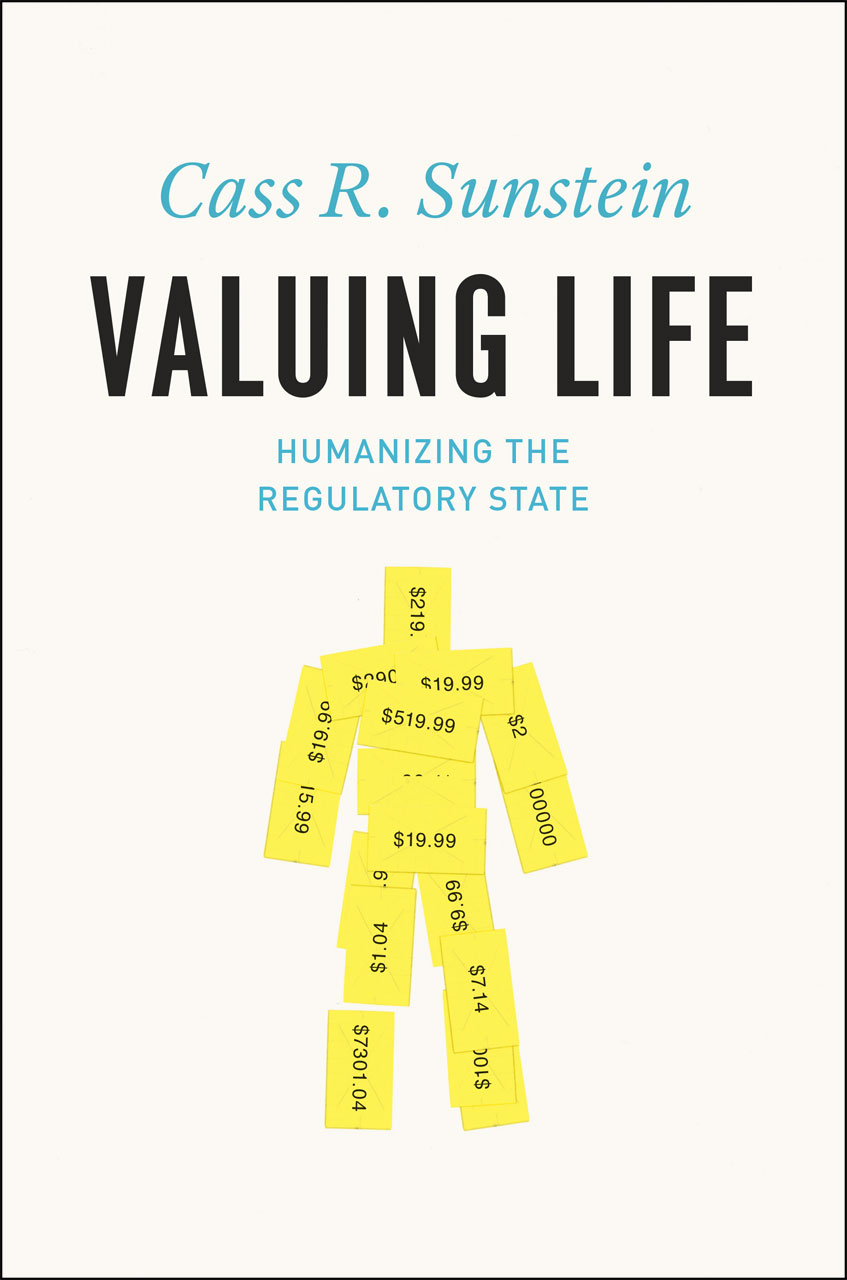In Valuing Life, Cass Sunstein surveys a wide range of practical research and real-life policymaking in his characteristically lucid style, offering a candid and humble account of his administrative tenure in Washington. He performs an invaluable service in revealing how government regulators balance pragmatic concerns of resource scarcity with principled ideals of respect and dignity, writes Mark D. White.
 Valuing Life: Humanizing the Regulatory State. Cass Sunstein. University of Chicago. 2014.
Valuing Life: Humanizing the Regulatory State. Cass Sunstein. University of Chicago. 2014.
There are many economists, philosophers, and legal scholars who write about the value of human life and how to incorporate it into policy, but few of them have actually put this into practice in a government position. The most prominent scholar to do so is Cass Sunstein, whose latest book, Valuing Life: Humanizing the Regulatory State, provides an invaluable perspective from someone who has experience in both the academic and policy realms. Sunstein served as administrator of the United States’ Office of Information and Regulatory Affairs (OIRA) from 2009 to 2012, and in Valuing Life he draws back the curtain to reveal how such valuations and decisions are made “on the ground.”
An underlying theme in Valuing Life is the human consequences of policy decisions. Throughout the book, Sunstein details the delicate balance he had to make between cost-benefit analysis, which uses economics, psychology, and other sciences to estimate the monetary consequences of regulations, and human factors that defy monetization, such as the impact of regulation on dignity and respect. For example, he explains the deliberations within OIRA concerning wheelchair access to public buildings, a decision involving monetary costs and nonmonetary benefits. OIRA applied breakeven analysis to such cases, determining what the monetary benefit would have to be to justify the costs and then making a judgment call, with a thumb placed heavily on the side of preserving dignity—in this case, universal access to public facilities. According to this nuanced and inclusive version of cost-benefit analysis, the benefits of regulation do not have to exceed the costs, but they do need to justify them, a burden that is more easily met when the regulation affects essential human rights and functionings.
Sunstein explains these deliberations from an administrative as well as an academic point of view. In the terms of the former, he details the process of regulation approval and reform within OIRA, and skeptics of government regulation (such as myself) will likely be surprised at the copious levels of safeguards in place within agencies such as OIRA to prevent arbitrary impositions of state power on individuals and firms. In terms of the latter, he provides numerous examples of various configurations of cost, benefits, and probabilities that he encountered; chapter two contains 36 such examples, all of them grounded in actual regulatory problems (with citations to supporting documents).
Two chapters of Valuing Life are devoted solely to the problem of valuing lives, which is critical to evaluating regulations meant to prevent fatal accidents. Sunstein anticipates resistance to this idea and counters it early, pointing out that all regulations have costs and no society can afford to spend unlimited resources to eliminate the chance of accidental death entirely (if that were even possible). As with his elaboration of the regulatory approval process, his discussion of how the value of a statistical life (or VSL) is determined and incorporated into regulation shows how carefully government decision-makers tread in this area. For example, OIRA relies on ranges of valuations from academic research, which are drawn from surveys of individuals’ willingness to pay to avoid certain amounts of risk. Sunstein does acknowledge problems with these figures, including those based on our well-known cognitive difficulties with assessing risk—itself a later topic in the book—but emphasizes the need for some estimate of VSL to guide policy that balances the costs of risk and resources.

One of the more interesting (and likely controversial) discussions in the book deals with the heterogeneity of attitudes toward risk, both among populations as well as between them, and the implications of VSL. Since each person’s VSL is based on stated willingness-to-pay to avoid risks, that figure will differ according to socioeconomic status, particularly wealth: those with more resources, who may regard themselves as having more to lose from risk, will be able and willing to pay more to avoid it, resulting in a higher personal VSL than those who do not have similar means. When these wealth-correlated VSL figures are used for policy decisions, however, they may be found objectionable, implying that a rich person’s life is of more value than that of a poor person, or the inhabitants of a developing country are worth less than those of a developed one.
Sunstein explains that VSLs are not a measure of moral worth but only a guide to policymaking that benefits all, especially if people must contribute to the cost of their own risk prevention. It does the poor person no good to have expensive safety features mandated in new cars if that puts the cars out of reach financially, and the same applies to public expenditures to improve air quality. By the same token, poor nations will be bankrupted if they use VSLs based from rich nations to guide their regulatory effects to lower risk. At the same time, Sunstein recognizes that the prevention of some risks, such as significant risks of illness due to poor air quality or violence due to high crime rates, should not be subject to willingness-to-pay measures, but may be considered a human right (which he compares to antidiscrimination laws). Such measures should be provided to all by the government, even if the burden of this regulation is borne disproportionately by the wealthy. But most regulations deal with marginal changes in risk that are more reasonably subject to cost-benefit analysis using the appropriate VSL, which approximates the choices individuals would make themselves.
One of the final chapters of Valuing Life looks closely at individual reactions to risk in the context of ethical decision-making. Sunstein introduces the concept of moral heuristics, applying the concept of decision-making heuristics familiar from psychology and behavioral economics to ethical choice. He argues that simple rules of thumb, such as “do not lie” and “promote happiness,” may be generally beneficial but can backfire in predictable contexts. One fascinating example is the popular disdain shown for automakers who use of cost-benefit analysis and VSL in product design; in product liability trials, juries impose higher damages on automakers who used these tools compared to those who made the same safety decisions using the less calculative logic. Another is our reaction to “betrayal risk,” in which we feel a greater injury from the same physical or monetary loss when it results from a violation of trust, even in terms of inanimate objects. In one study, people were willing to pay more for the same reduction in the risk of injury from a car crash when the risk came specifically from a faulty airbag (because airbags are “supposed to” protect them). This may be dismissed as a matter of individual preference or principle, but it can have broader effects, such as when parents refuse to vaccinate their own children and as a result endanger others.
In this context of individual reactions to risk, Sunstein also addresses “probability neglect,” by which people ignore probability altogether when the risked event is particularly emotional or visceral (such as terrorist attacks or viral outbreaks). He recommends rational discussion of such risks to defuse emotional reactions to them, but also acknowledges that even irrational fear is nonetheless fear, real to the people experiencing it and potentially costly, and admits that, in some cases, government may have to respond to it, as they would in response to any other costs.
In Valuing Life, Cass Sunstein surveys a wide range of practical research and real-life policymaking in his characteristically lucid style, offering a candid and humble account of his administrative tenure in Washington. He performs an invaluable service in revealing how government regulators balance pragmatic concerns of resource scarcity with principled ideals of respect and dignity. There is certainly room for argument on how these are balanced, but even the most trenchant critics of government can admire the fact that such a wide range of factors are considered so carefully.
Mark D. White is the chair of the Department of Philosophy at the College of Staten Island/CUNY, where he teaches courses in philosophy, economics, and law. His most recent book is The Illusion of Well-Being: Economic Policymaking Based on Respect and Responsiveness (Palgrave, 2014). He can be found on Twitter and at his website. Read more reviews by Mark.








I guess Lois Lerner, Phillip North, Tom Perez, Gina McCarthy, and Gary Grindler all called in sick the day Cass gave his PowerPoint presentation on arbitrary impositions. For Pete’s Sake, Perez was promoted to Secretary of Labor specifically because he did carry the water in making arbitrary impositions in Minnesota. If Lerner was not making arbitrary impositions, why did they shred her hard drive and disappear her phone records? Gina McCarthy’s entire record of sent and received texts has been disappeared, yet somehow she remains EPA administrator. If that happened in private industry, the board would need to fire the CEO with the ambulance chasers howling at the boardroom door. “Skeptics of government regulation (such as myself) will likely be surprised at the copious levels of safeguards in place within agencies such as OIRA to prevent arbitrary impositions of state power on individuals and firms,” was good for a belly laugh. The Holder Justice Department gave Cass’ administration a 6-year hall pass, rendering the “safeguards” Cass refers to meaningless.
Despite Cass’ bleating, the administration in which he served politicized regulations in order to place friends above the law and punish enemies. Cass’ administration’s cost/benefit analysis boiled down to, “We are good. They are bad. Therefore we must stop and punish them via regulatory fiat. That’s good for the world.” Cass’ administration did so with no regard to destroying the U.S. citizen’s faith that the system will not be politicized. Cass can spend the rest of his life telling people how careful he was and how he hated additional regulation. The truth is his regulations stymied the recovery and are choking small business’ ability to survive let alone grow. Cass’ administration applied regulations based not on what was good or not good, fair or unfair, lawful or illegal, or with an eye for what would withstand Judicial review or even a public airing before Congress, but based only on what the Obama administration deemed good for expanding its own power now.
As we’ve seen with Secretary Geitner’s book, I suspect it will be only a year or two until it’s proven that what Cass has written has little connection to what actually transpired.
Besides the review accepting Cass’ fantasy as non-fiction, it’s very well written.